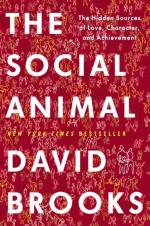
|
| Name: _________________________ | Period: ___________________ |
This test consists of 15 multiple choice questions and 5 short answer questions.
Multiple Choice Questions
1. Who introduces Erica to Harold?
(a) Mark.
(b) Her mother.
(c) A friend of Erica's.
(d) Harrison.
2. What does Brooks call the new stage of life?
(a) The odyssey years.
(b) The victmhood years.
(c) The resignation years.
(d) The windfall years.
3. In Chapter 15, Brooks states that the unconscious mind can perform complex tasks without what?
(a) Our being awake.
(b) Taking in stimuli.
(c) Achieving a conclusion.
(d) Alerting the conscious mind.
4. In Chapter 8, what step does Brooks suggest is most important to decision-making?
(a) Frustration.
(b) Execution.
(c) Perception.
(d) Calculation.
5. What does Mark say he is in search of in Chapter 12?
(a) Intense world.
(b) Neverland.
(c) More money than God.
(d) Perfect moments.
6. As Erica makes her way through the Academy, she becomes what type of person?
(a) A competitor.
(b) An organizer.
(c) An introvert.
(d) An artist.
7. In Chapter 14, Brooks states that the Recession led to an essential reduction in what?
(a) Home ownership.
(b) Hiring.
(c) Coroporate lending.
(d) Risk-taking.
8. What does Erica decide to do at the end of Chapter 10?
(a) Enter politics.
(b) Travel for a year.
(c) Go back to school.
(d) Start her own firm.
9. What personal problem does Harold begin having after he becomes romantically involved with Erica?
(a) He wants to take things slower than she does.
(b) He yearns for her all the time.
(c) He becomes less attracted to her.
(d) He wants to cheat on her.
10. Which of the following is a precaution Erica takes in Chapter 13 to ensure there is no romantic connotation to her work with Harold?
(a) She always wears a pants suit.
(b) She insists they work in different locations.
(c) She shuts the bedroom door.
(d) She puts up pictures of her husband in the office.
11. What institution does Herold begin working for in Chapter 15?
(a) GE.
(b) The Historical Society.
(c) The University of Maryland.
(d) The Peace Corps.
12. In Chapter 13, what term does Brooks use to describe the mechanism that tells us how we are viewed?
(a) Self-assessor.
(b) Personal review.
(c) Image monitor.
(d) Status sonor.
13. At the end of Chapter 15, what does Brooks characterize the relationship between the conscious and the unconscious mind as?
(a) A marriage.
(b) A corporate partnership.
(c) A rivalry.
(d) A war.
14. Which of the following is not a culture Erica immerses herself in at college?
(a) History.
(b) Literature.
(c) Psychology.
(d) Sociology.
15. What disorder does Amy have?
(a) OCD.
(b) Manic depressive disorder.
(c) Aspurgers.
(d) Diabetes.
Short Answer Questions
1. Which of the following is not an acquisition Taggart makes for Intercom?
2. What field does Erica explore in Chapter 11?
3. What did Walter Mischel suggest children do in his marshmallow experiment which helped them wait longer to eat the candy?
4. What does Erica feel about the new workers she hires in Chapter 14?
5. According to the Rationalists, what adversely affects business?
|
This section contains 487 words (approx. 2 pages at 300 words per page) |

|




